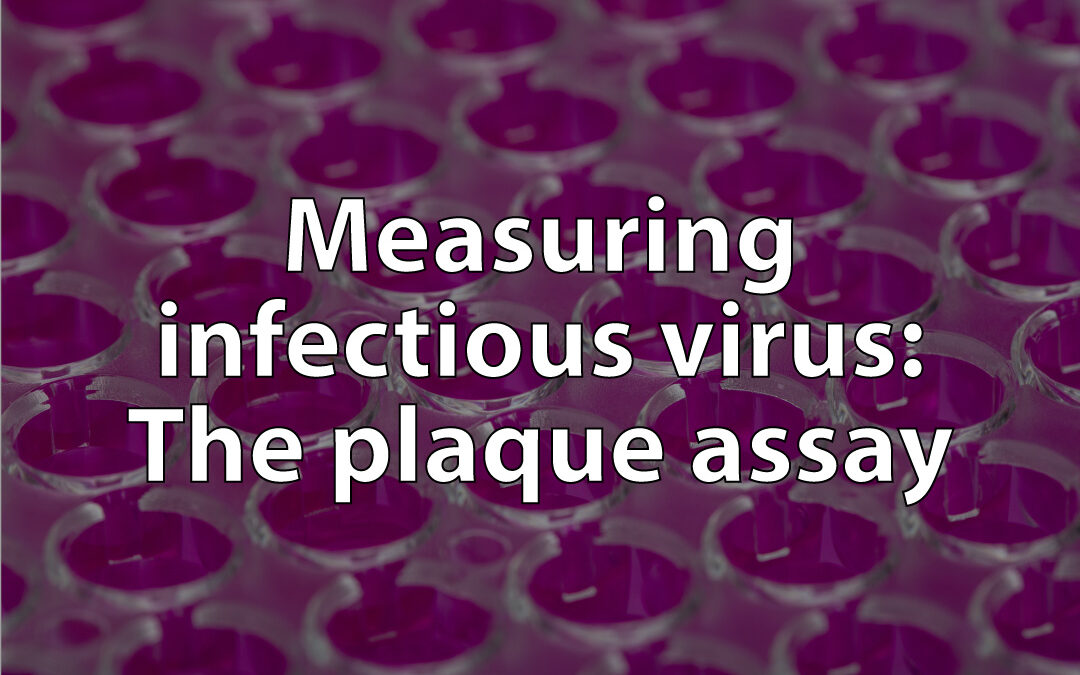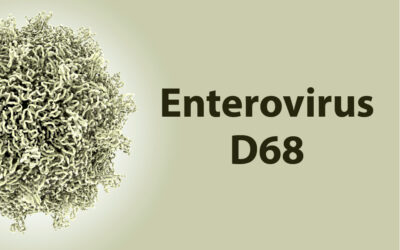The amount of virus contained in a sample is crucial information for anyone working with viruses. But how can you quantify viruses? One method is the plaque assay, which specifically measures infectious virus particles. The assay involves adding viruses to permissive cells and applying a semisolid overlay that limits the spread of infection to neighbouring cells, while cell death leads to the formation of plaques. It is one of the most established and reliable methods in virology and well worth learning more about.
Infection and plaque formation
Plaque assays require cultured cells susceptible to infection by the virus of interest. The cells are first seeded onto a surface they can adhere to and grow on, then left overnight to form a confluent monolayer (a cohesive sheet of cells covering the entire growth surface). A virus sample is then diluted several times, and an aliquot of each dilution is added to a dish or well of cells. An incubation period allows the virus to attach to target cells before removing the inoculum. The culture is then covered with a medium containing nutrients and a substance, such as agarose or methylcellulose, forming a gel or semisolid overlay. Infectious virus particles that enter cells and replicate can then trigger the release of progeny virions. The gel restricts particle movement so that newly produced viruses can only infect neighbouring cells. If the virus kills infected cells, the dead (or dying) cells detach and create a hole in the monolayer through lysis or other means. This space – now devoid of cells –is called a plaque and appears as circular spots on the growth surface.
The plaques are allowed to grow until visible to the naked eye. The cells are then fixed with formaldehyde to lock cellular structures while killing the cells and virus. Dyes that stain cells are added for contrast, making plaques easier to see. Purple violet stains the cells purple, while plaques, lacking cells, remain clear. Cells that remain adhered to the surface are assumed to be uninfected, and apparent plaques are assumed to arise from cell death caused by infection. That is why the virus dilutions must be added to confluent monolayers with no gaps that might later be mistaken for plaques.
Viral titre: PFU/ml
Multiple dilutions of the stock sample are analysed to identify one or more dilutions that give rise to a countable number of plaques. At the lowest dilutions, too many infectious particles will destroy large swaths of the cell monolayer or create plaques too numerous and overlapping to distinguish. At the highest dilutions, there may be no plaques at all. At the optimal dilutions, plaques are counted to determine the titre of the original stock sample, typically reported as the number of plaque-forming units per millilitre (PFU/ml).
For a given plaque count, the stock titre can be calculated by simple arithmetic based on the volume of the aliquot added to the cells and the sample dilution the aliquot was drawn from. As a basic example, if 35 plaques were counted when a 0.1 ml aliquot of the 10-5 dilution was added to the cells, the titre of the undiluted stock is 3.5×107 PFU/ml. For reliable titres, each sample dilution should be plated multiple times, at least in duplicate and preferably in triplicate. Furthermore, multiple dilutions may result in countable plaques. More elaborate formulas incorporating all relevant plaque counts are typically used to calculate titres.
PFU/ml vs IU/ml
The assay is designed so that each plaque results from infection by multiplying a single infectious virus particle. As such, PFU/ml is considered a measure of the number of infectious units per millilitre (IU/ml), with the caveat that one cannot be certain of a one-to-one ratio of plaques to infectious particles in the applied aliquot. Also, be aware that the titre of a sample is specific to the assay conditions used to determine it, as infectivity is influenced by many factors, such as the type of host cell, pH, and culture medium. Titres can differ by several orders of magnitude by changing key assay parameters.
Human vs machine
The size and format of the cell growth surface also need consideration. Common choices include larger individual dishes or multi-well plates containing several smaller separate surfaces of uniform size. At VRS, we often perform plaque assays in 6-well plates, with each well having a diameter of roughly 35 mm and allowing identification of upwards of 200 distinct plaques. The traditional method of counting plaques by eye is still common, although plates can be imaged, and the pictures are subsequently analysed using computer software. Specialised automated instruments that manage images and count plaques greatly increase processing efficiency. Such instruments can identify smaller plaques, permitting shorter incubation times and making it feasible to use more high-throughput plate options with small individual wells, such as 96-well plates.
Limitations
The benefits of specialised instruments for analysing plaques reveal some of the limitations of the assay. There is a significant waiting period for visible plaques to develop, especially when they need to be scored by eye. Countable plaques typically take 4 to 10 days to develop, depending on the virus. The assay can also be quite laborious, involving low-throughput cell culture formats and the need to count potentially thousands of plaques. Plaque counting also introduces human error and operator variation. Though faster and more consistent, machine scoring does not always accurately identify plaques.
Focus forming assay
The greatest limitation of the plaque assay is that not all viruses form plaques. Some viruses do not kill their host cells and, therefore, do not create gaps in the monolayer. In such instances, a focus-forming assay can detect groups of infected cells, known as foci. The assay proceeds like a plaque assay to generate localised clusters of infected cells, but these foci are detected using an antibody specific to the virus of interest. Attaching a fluorescent molecule to an antibody allows it to be viewed by fluorescence microscopy. Alternatively, antibodies can be tagged with an enzyme, such as horseradish peroxidase that cleaves a substrate to generate a detectable coloured product. Once visualised, foci are counted, and titres are reported as the number of focus-forming units per ml (FFU/ml). Focus-forming assays are also useful for plaque-forming viruses because foci are detectable before visible plaques, meaning shorter incubation times are required. On the downside, procuring and detecting antibodies add significant costs to virus quantitation. Furthermore, the focus-forming assay is not an option if an appropriate antibody is unavailable, as is often the case with new and emerging pathogens.
Alternatives to infectivity assays
In contrast to infectivity assays, electron microscopy can be used to visualise and count individual virus particles. Alternatively, viral components (e.g., DNA, RNA, or protein) can be measured using real-time PCR, Western Blot, ELISA, and flow cytometry. However, unlike plaque and focus forming assays, these methods do not measure infectivity. A virus sample will include infectious particles and inactive virions that are incapable of cell entry and reproduction. Thus, visualising viruses by electron microscopy or quantifying viral protein by ELISA does not provide information on the infectious virus. Conversely, infectivity assays like the plaque assay detect the infectious virus but not total virus particles.
TCID50
Before the culture of mammalian cells was well established, animal viruses had to be quantified by treating test animals or embryonated eggs with serial dilutions of a virus sample. Death or other signs of illness were then used as markers for infection. Inoculation with multiple dilutions helped identify a dilution that infected only some of the animals or eggs, with lower dilutions infecting all test subjects and higher dilutions infecting none. One could then calculate the virus dilution that infects 50% of the subjects. This type of endpoint dilution assay is now more commonly performed with cultured cells in what is known as the Tissue Culture Infectious Dose 50 assay or TCID50, a topic covered in a previous VRS blog. While the TCID50 assay is easier and facilitates higher throughput, the plaque assay provides more accurate titres.
An ageless assay
Despite its long history, the plaque assay has refused to become a relic of the past. It was around 1917 when Felix d’Herelle established the first version of a plaque assay. His method quantified bacteriophages, which are viruses that infect bacteria. In the early 1950s, eventual Nobel Prize winner Renato Dulbecco and his colleague Marguerite Vogt modified the bacteriophage plaque assay to quantify animal viruses1, and their method has withstood the test of time. This work was made possible by the same advancements in mammalian cell culture techniques that allowed endpoint dilution assays to move from live animals to cells in multi-well plates. Since then, technical and scientific advances have spawned myriad new techniques in virology, yet the plaque assay remains a unique, gold standard tool for quantifying viruses.
References
- Dulbecco R, Vogt M. 1953. Some problems of animal virology as studied by the plaque technique. Cold Spring Harb Symp Quant Biol. 18:273-9.
Blog by Farrell MacKenzie
Edited by Reckon Better Scientific Editing




